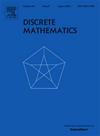Components of domino tilings under flips in quadriculated tori
IF 0.7
3区 数学
Q2 MATHEMATICS
引用次数: 0
Abstract
In a region R consisting of unit squares, a (domino) tiling is a collection of dominoes (the union of two adjacent squares) which pave fully the region. The flip graph of R is defined on the set of all tilings of R where two tilings are adjacent if we change one from the other by a flip (a rotation of a pair of side-by-side dominoes). If R is simply-connected, then its flip graph is connected. By using homology and cohomology, Saldanha, Tomei, Casarin and Romualdo obtained a criterion to decide if two tilings are in the same component of flip graph of quadriculated surface. By a graph-theoretic method, we obtain that the flip graph of a non-bipartite quadriculated torus consists of two isomorphic components. As an application, we obtain that the forcing numbers of all perfect matchings of each non-bipartite quadriculated torus form an integer-interval. For a bipartite quadriculated torus, the components of the flip graph is more complicated, and we use homology to obtain a general lower bound for the number of components of its flip graph.
在一个由单位正方形组成的区域 R 中,(多米诺)平铺图是多米诺的集合(相邻两个正方形的结合),它们铺满了整个区域。R 的翻转图定义在 R 的所有平铺集合上,如果我们通过翻转(将一对并排的多米诺骨牌旋转 90∘)改变其中一个平铺,则两个平铺相邻。如果 R 是简单连通的,那么它的翻转图就是连通的。萨尔达尼亚、托梅、卡萨林和罗穆阿尔多利用同源性和同调性,获得了判定两个翻转图是否在四曲面翻转图的同一分量中的标准。通过图论方法,我们得到了非双面四曲面环的翻转图由两个同构分量组成。作为应用,我们得到每个非双曲二次曲面环的所有完全匹配的强制数都构成一个整数区间。对于双方四曲面环,翻转图的分量更为复杂,我们利用同源性得到了其翻转图分量数的一般下限。
本文章由计算机程序翻译,如有差异,请以英文原文为准。
求助全文
约1分钟内获得全文
求助全文
来源期刊

Discrete Mathematics
数学-数学
CiteScore
1.50
自引率
12.50%
发文量
424
审稿时长
6 months
期刊介绍:
Discrete Mathematics provides a common forum for significant research in many areas of discrete mathematics and combinatorics. Among the fields covered by Discrete Mathematics are graph and hypergraph theory, enumeration, coding theory, block designs, the combinatorics of partially ordered sets, extremal set theory, matroid theory, algebraic combinatorics, discrete geometry, matrices, and discrete probability theory.
Items in the journal include research articles (Contributions or Notes, depending on length) and survey/expository articles (Perspectives). Efforts are made to process the submission of Notes (short articles) quickly. The Perspectives section features expository articles accessible to a broad audience that cast new light or present unifying points of view on well-known or insufficiently-known topics.
 求助内容:
求助内容: 应助结果提醒方式:
应助结果提醒方式:


